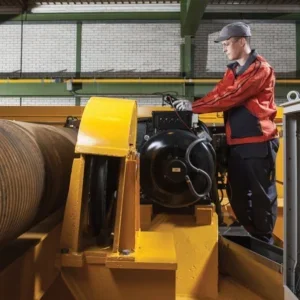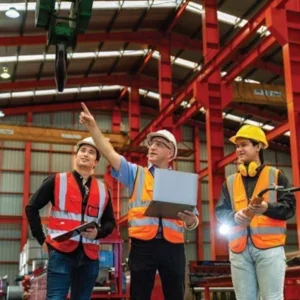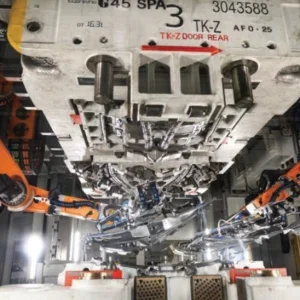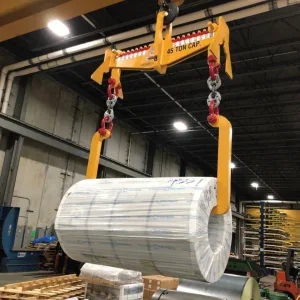Cranes are one of the longest-lasting items of factory equipment and it is common to find units that have been in service for up to 50 years. During that time, most factories have gone through enormous changes on the shop floor, where computerised production equipment has taken over from old manual or semi-automatic machines. In many cases, the cranes have not changed to the same extent. Although each unit will have been maintained in line with the required safety standards, and new systems such as remote control and modern drives may have been fitted, the basic crane structure has often altered very little since the day it was installed.
With continuing pressure to reduce production costs and increase output, many factory managers now face the challenge of how to optimise their investment in cranes and associated material handling equipment. Should they refurbish the existing cranes, upgrade them to handle higher loads and increased operating speeds, or scrap the existing units and install new ones?
Tom Laughlin of Houston based crane maintenance specialist Crane Pro 21 comments that the need to make the decision is usually prompted by one of four situations:
• An inspection reveals that the crane is no longer safe because of excessive wear or non-compliance with safety requirements
• More speed, lifting capacity or control are needed, or performance requirements are changing • The crane has been working close to or even beyond its operational limit, causing maintenance costs and associated downtime to rise dramatically • Some parts are obsolete or outdated, even though others are still operating satisfactorily.
He comments that if a 20- to 30-year-old crane is to be replaced, the new unit is likely to cost seven to 10 times the original price. It is therefore not surprising that many users are examining the cost of refurbishment or upgrading. Refurbishment differs from upgrading in that when a crane is refurbished, its original specification remains largely unchanged. Upgrading is usually associated with an increase in lifting capacity, and can involve considerable re-engineering of components such as bearings, shafts, axles, brakes and sometimes also the basic structure of the unit. In either case, new technology such as remote control and the latest motors and drives could also be added.
Discussions with crane manufacturers and maintenance specialists revealed some common areas that they felt should be considered when a factory manager is deciding whether to spend money on existing cranes or to buy new ones. These are summarised below.
Review the crane’s maintenance history
Maintenance records are the most valuable source of data concerning a crane’s condition and can give an indication of where upgrading needs to be considered. Common weak spots on older cranes are mechanical rather than electrical brakes, outdated control systems, older designs of gears and uneven wear on drum shafts and wheels caused by structural movement. This structural movement results from gradual relaxation of the internal stresses that were set up within the crane structure when it was originally welded together.
Tom Laughlin comments that it is common to find that “the 80/20 rule” applies, with 80% of the failures caused by 20% of components, and that each industry tends to have particular maintenance headaches. For instance, EOT cranes in steel warehouses suffer from excessive wheel wear and problems with drive machinery, girder connections and bridge end trucks caused by the repetitive nature of their duty cycles. In paper mills, load brake failure on reel cranes is an area to watch, as increasing throughputs in recent years has meant that these cranes are often required to work close to their design limits. Failure can cost up to $20,000/hour.
Some problems, such as motor overheating, motor brake failure and undersized contactor tips wearing out are common to all industries but nearly always result from increased frequency of operation.
Review operating parameters, evaluate existing crane specs
The review of the crane’s maintenance history will have given some clues regarding areas where the factory’s current operating parameters may differ from the original specification used to select the crane when it was first installed. More detailed analysis may show that although the crane measures up in terms of such basic features as lifting capacity, it may not have been designed to be used as frequently as it currently is, or to be operated at the speeds now required.
This analysis should cover an examination of the loads to be lifted, including an assessment of the percentages that will be at 100%, 75%, 50% and 25% of rated capacity, the travel distances and speeds required, slinging times and average working hours. The calculations to establish the crane specification needed for the job can be quite complex, so the factory manager should consider talking to a manufacturer or maintenance specialist. Many use computer-aided design packages which can produce an answer in minutes.
At this point, the crane’s structure should be assessed to establish its remaining useful life at its current capacity, and whether capacity can be increased. Mechanical design practices used to be more conservative than they are today, so a crane’s structure will often outlast the mechanical and electrical components by many years, as well as being able to support heavier loads, especially if it is reinforced. According to Jim Nelson of Seattle-based manufacturer Ederer, capacity increases of up to 25% are often achievable with existing crane structures.
Large structural components are a major part of the cost of a crane, so the ability to re-use them, even if they need to be modified, can be the deciding factor that makes the difference between keeping a crane or replacing it.
Establish the cost of refurbishment, upgrading or renewal
The review of operating parameters and evaluation of the existing crane specification will have established whether the crane can be refurbished or upgraded to meet the factory’s needs. If it cannot, a new crane will be the only option.
Assuming that refurbishment or upgrading would be viable, the factory manager will by now have compiled a detailed specification for the required work, so will be in a position to enter into detailed discussions with suppliers over costs. It should be remembered that even if no load increase is needed, it will be worthwhile to consider the latest designs of motors and drives for improved reliability, speed and accuracy. Modifications such as radio or infra-red remote control systems in place of pendant or cab control should also be considered at this point.
Given the range of ‘required’ and ‘optional’ features to be considered, the costing exercise may require lengthy discussions with suppliers and a detailed review of possible price/performance trade-offs. Again, computer aided design systems can help, as they enable different options to be evaluated very quickly.
Consider the costs of removal, replacement and downtime
Having reached a compromise between performance, optional features and price, and established the cost of an optimum refurbishment or upgrade package, the time has come to decide whether to spend money on the existing crane or to buy a new one. However, before a final decision can be made, the costs associated with the site work needed in each case must be considered.
Tom Laughlin comments that removal and installation costs can be substantial. “In some older plants where the structure has expanded around the crane, removing the old and installing the new one is often very difficult or cost-prohibitive,” he says. “It is not unusual in such cases for the cost of removal/replacement to approach that of the new crane, thus doubling the equipment figure. This cost is in addition to any required downtime”.
Both refurbishment and replacement will cause some disruption, and considerable downtime may be required. On the other hand, refurbishment can be quick, as modular or part-assembled components can be used. These can be readied off-site, so the crane will only be out of action for the time taken to fit and commission them.
For many users, replacement may initially appear to be the best option because the cost of upgrading an old unit to handle heavier loads and an increased duty cycle can come close to, or even in some cases exceed, the cost of a new unit. However, when the associated removal, replacement and downtime costs are taken into account, it is easy to see why maintenance specialists are seeing increasing levels of enquiries.
Tom Laughlin concludes: “There are a lot of older, but high quality cranes out there with problems. Obviously, we see this as a tremendous business opportunity. But we’re pleased that our customers are also beginning to perceive their crane problem not as a catastrophe, but as an opportunity for them as well. True modernisation does more than replace worn parts – it provides the benefits of engineering advances, extends the useful life of the machine, and may create a crane with significantly higher capacity or improved duty cycle.”






